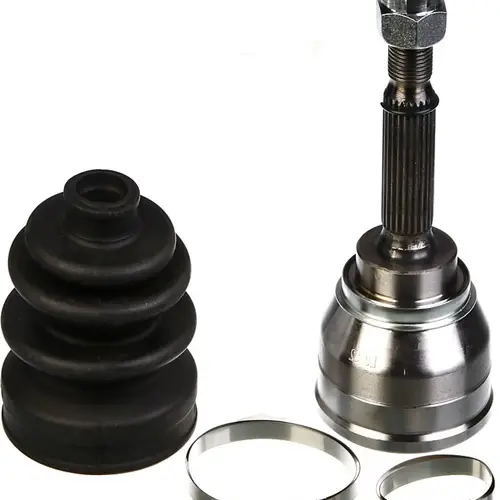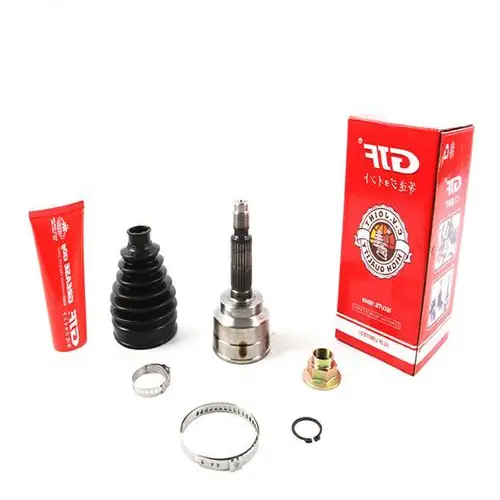
High Quality Outer CV Joint for Lantra/Sonata Air Compressor
Product Description
CV Joint is a device designed to connect two shafts at an angle or with changes in their relative positions, ensuring they transmit power at the same angular velocity. This solution addresses speed inconsistencies and is pivotal for automotive performance. The widely used constant velocity universal joints include two primary types: ball fork type universal joints and ball cage type universal joints.
Compatibility and Range
Our CV Joints are compatible with a plethora of vehicles. We offer over 10,000 different items, ensuring a fit for most cars. By referencing your OEM number list, we can swiftly match the specific CV Joint specifications, vehicles, and pricing tailored to your needs. These joints are especially popular among Japanese, Korean, German, European, and American cars.
Workshop and Team Commitment
Our workshop is equipped with state-of-the-art technology and staffed by skilled professionals dedicated to creating high-quality automotive parts. Our team is committed to delivering excellence and innovation in every product we manufacture.
Other Products by EVER-POWER GROUP
EVER-POWER GROUP is renowned for its comprehensive range of industrial products, including:
- Agricultural gearboxes
- Power output shafts
- Sprockets
- Fluid couplings
- Worm gear reducers
- Gears and racks
- Roller chains
- Pulleys and pulleys
- Planetary gearboxes
- Timing pulleys
- Bushings
We pride ourselves on high-quality products, competitive pricing, and exceptional service. Customers are welcome to provide custom drawings and samples for tailored solutions. Our commitment to quality and customer satisfaction remains unwavering.
FAQs
- What vehicles are compatible with your CV joints?
Our CV joints are compatible with a wide range of vehicles, including Japanese, Korean, German, European, and American cars. - How can I ensure the CV joint fits my vehicle?
By providing your OEM number, we can match the specific CV joint specifications, ensuring a perfect fit for your vehicle. - What types of CV joints do you offer?
We offer ball fork type and ball cage type universal joints, both widely used for their reliability and performance. - What other products does EVER-POWER GROUP offer?
We supply a variety of industrial products, including agricultural gearboxes, sprockets, fluid couplings, and more. - Can I customize orders with EVER-POWER GROUP?
Yes, customers are welcome to provide custom drawings and samples for tailored solutions suited to their specific needs.
All the content of the page is from the Internet, the content is only as a reference for product selection, our products are replacement parts and not original spare parts; we are not the holder of the original trademarks of the content, our products are only suitable for after-sales replacement parts and not original spare parts, our replacement parts can be perfectly adapted to the original spare parts; if you need to buy original spare parts, please contact the original factory to buy. If you want to buy original spare parts, please contact the original supplier for purchase.
Performance Characteristics of CV Joint
Constant Velocity (CV) joints are crucial components in automotive drivetrains, providing seamless power transfer while allowing for a wide range of motion. These joints perform exceptionally well due to their unique attributes:
- Smooth Power Transmission: CV joints ensure uniform power delivery to the wheels, reducing vibrations and increasing vehicle stability.
- High Durability: Made from robust materials, CV joints can withstand substantial stress and wear, ensuring long-term reliability.
- Flexibility: These joints allow for the necessary flexibility in the drivetrain, accommodating the up and down movements of the suspension.
- Maintenance Requirements: Regular inspection and lubrication can significantly prolong the life of CV joints, minimizing the need for frequent replacements.
Types and Characteristics of CV Joint
There are primarily two types of CV joints:
- Rzeppa Joints: Often used in front-wheel-drive vehicles, these joints provide a constant velocity ratio and are highly efficient at extreme angles.
- Tripod Joints: These are typically found at the inboard end of drive shafts and are designed to handle axial motion smoothly.
The material composition of CV joints also varies, impacting their performance and characteristics:
- Steel CV Joints: Known for their high strength and durability, steel CV joints are ideal for heavy-duty applications.
- Composite CV Joints: Lighter than steel, composite materials offer enhanced fuel efficiency without compromising performance.
- Chromoly CV Joints: These provide superior strength and resistance to wear, making them suitable for high-performance vehicles.
Application of CV Joint in Various Fields
The versatility of CV joints makes them indispensable in various fields:
- Automotive Industry: CV joints are critical in both front-wheel and rear-wheel drive vehicles, ensuring efficient power transfer and smooth operation.
- Industrial Machinery: In industrial applications, CV joints help transmit power in machinery that requires a high degree of flexibility and precision.
- Aerospace: CV joints are used in aircraft control systems, providing the necessary flexibility for complex movements.
- Marine Equipment: These joints ensure reliable power transmission in boats and ships, accommodating the movements of marine propulsion systems.
- Agricultural Equipment: In tractors and other farm machinery, CV joints accommodate the uneven terrain and dynamic movements, enhancing operational efficiency.
Future Development Trends and Opportunities for CV Joint Products
The advancement of CV joint technology is driven by the demand for better performance and sustainability:
- Material Innovation: The development of new materials, such as advanced composites and high-strength alloys, is expected to enhance the durability and efficiency of CV joints.
- Electrification: With the rise of electric vehicles, CV joints are being designed to handle the unique torque characteristics of electric drivetrains.
- Advanced Manufacturing Techniques: Techniques like 3D printing are enabling more precise and cost-effective production of CV joints.
- Sustainability: There is a growing focus on developing CV joints that are more environmentally friendly, through the use of recyclable materials and energy-efficient manufacturing processes.
How to Choose a Suitable CV Joint
Selecting the right CV joint involves several critical factors:
- Determine Application Requirements: Understand the specific needs of your application, including the type of vehicle or machinery.
- Evaluating Power Requirements: Ensure that the CV joint can handle the power output of your engine or motor.
- Check Speed and Torque Specifications: Verify that the joint meets the necessary speed and torque ratings for your application.
- Measuring the Length of the Shaft: Accurate measurements ensure proper fitment and optimal performance.
- Evaluate Connection Type: Ensure the CV joint is compatible with your existing drivetrain connections.
- Check Safety Features: Look for joints that offer additional safety features to protect against failure in extreme conditions.
Summary
CV joints play a pivotal role in the efficient operation of various mechanical systems, from automotive to industrial machinery. Understanding their performance characteristics, types, applications, and future trends can help in selecting the right CV joint for your needs. By considering factors such as application requirements, power, speed, torque, and safety features, you can ensure optimal performance and longevity of your CV joint.
Author: Dream











